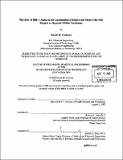| dc.contributor.advisor | Rakesh K. Jain. | en_US |
| dc.contributor.author | Cochran, David M., Ph. D. Massachusetts Institute of Technology | en_US |
| dc.contributor.other | Harvard University--MIT Division of Health Sciences and Technology. | en_US |
| dc.date.accessioned | 2008-02-28T16:17:08Z | |
| dc.date.available | 2008-02-28T16:17:08Z | |
| dc.date.copyright | 2005 | en_US |
| dc.date.issued | 2005 | en_US |
| dc.identifier.uri | http://dspace.mit.edu/handle/1721.1/33841 | en_US |
| dc.identifier.uri | http://hdl.handle.net/1721.1/33841 | |
| dc.description | Thesis (Ph. D.)--Harvard-MIT Division of Health Sciences and Technology, 2005. | en_US |
| dc.description | Includes bibliographical references (leaves 172-183). | en_US |
| dc.description.abstract | In embryonic stem (ES) cell tumors, the hypoxia-inducible transcription factor, HIF- 1[alpha], has been shown to be a tumor suppressor, and HIF-1[alpha]-expressing cells have been shown to localize preferentially in vivo to regions near tumor vasculature. These differences were proposed to be due to increased hypoxia-induced apoptosis and growth arrest of HIF-1[alpha]-expressing ES cells. This thesis presents a careful investigation into the localization of ES cells in vitro and in vivo with respect to hypoxia. A sandwich culture system was utilized in which controlled gradients of oxygen and nutrients are developed in the vicinity of the tumor cells. A diffusion-consumption model was utilized to predict the oxygen and glucose concentration profiles within the system. Oxygen and glucose consumption rates were measured and used as inputs into the model, and the concentration profiles were found to depend on a single experimental parameter, the cell density within the system. The optimum cell density was found in which stable, measurable oxygen gradients develop over 2-3 mm. The model demonstrated excellent agreement between the predicted oxygen concentration profiles and experimentally determined oxygen gradients. In vitro, there was no difference in localization with respect to hypoxia between tumor cells expressing or lacking HIF-1[alpha]. | en_US |
| dc.description.abstract | (cont.) In addition, there was no difference in apoptosis, proliferation, or migration of the tumor cells in vitro based on HIF-1[alpha] expression. Likewise, a quantitative study on localization of tumor cells within tumors in vivo demonstrated no difference between localization of HIF-1[alpha]-expressing vs. HIF-1[alpha]-lacking ES cells within tumors with respect to blood vessels or hypoxia. These results differ from previous studies, perhaps due to clonal variation of the cell phenotype or the interplay of other complex environmental factors that were not considered in this study. Interestingly, the HIF-1[alpha]-lacking cells were found to exhibit increased tumor growth relative to the HIF-1[alpha]-expressing cells, perhaps due to a normalization of the blood vessels within the HIF-1[alpha]-lacking tumors. These studies reveal the complex role of HIF-1[alpha] in tumor growth and tumor cell localization, as well as develop a useful quantitative experimental model for studying the role of the microenvironment in tumors or in embryonic stem cell biology. | en_US |
| dc.description.statementofresponsibility | by David M. Cochran. | en_US |
| dc.format.extent | 183 leaves | en_US |
| dc.language.iso | eng | en_US |
| dc.publisher | Massachusetts Institute of Technology | en_US |
| dc.rights | M.I.T. theses are protected by copyright. They may be viewed from this source for any purpose, but reproduction or distribution in any format is prohibited without written permission. See provided URL for inquiries about permission. | en_US |
| dc.rights.uri | http://dspace.mit.edu/handle/1721.1/33841 | en_US |
| dc.rights.uri | http://dspace.mit.edu/handle/1721.1/7582 | |
| dc.subject | Harvard University--MIT Division of Health Sciences and Technology. | en_US |
| dc.title | The role of HIF-1 alpha in the localization of embryonic stem cells with respect to hypoxia within teratomas | en_US |
| dc.type | Thesis | en_US |
| dc.description.degree | Ph.D. | en_US |
| dc.contributor.department | Harvard University--MIT Division of Health Sciences and Technology | |
| dc.identifier.oclc | 65466039 | en_US |
